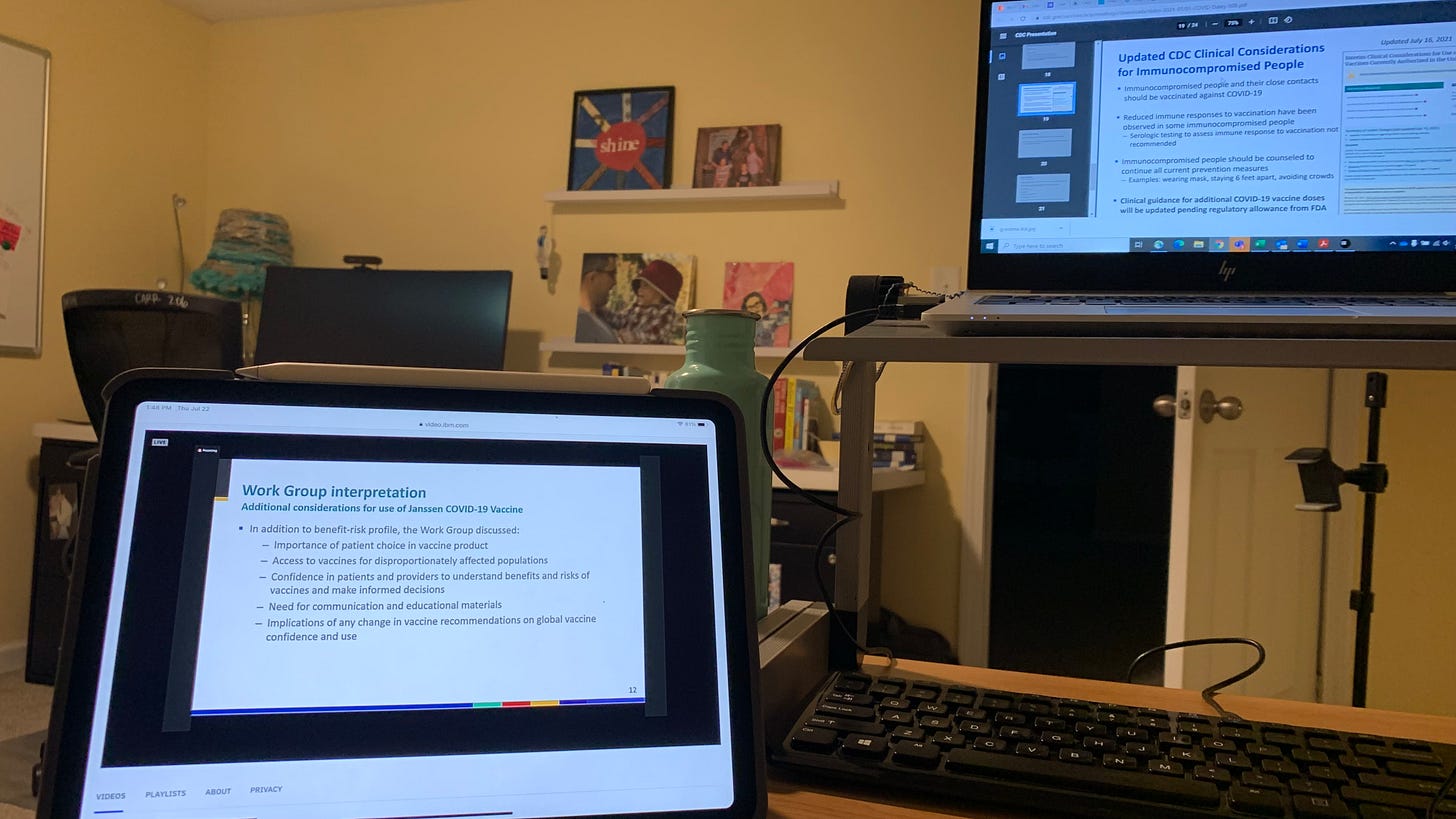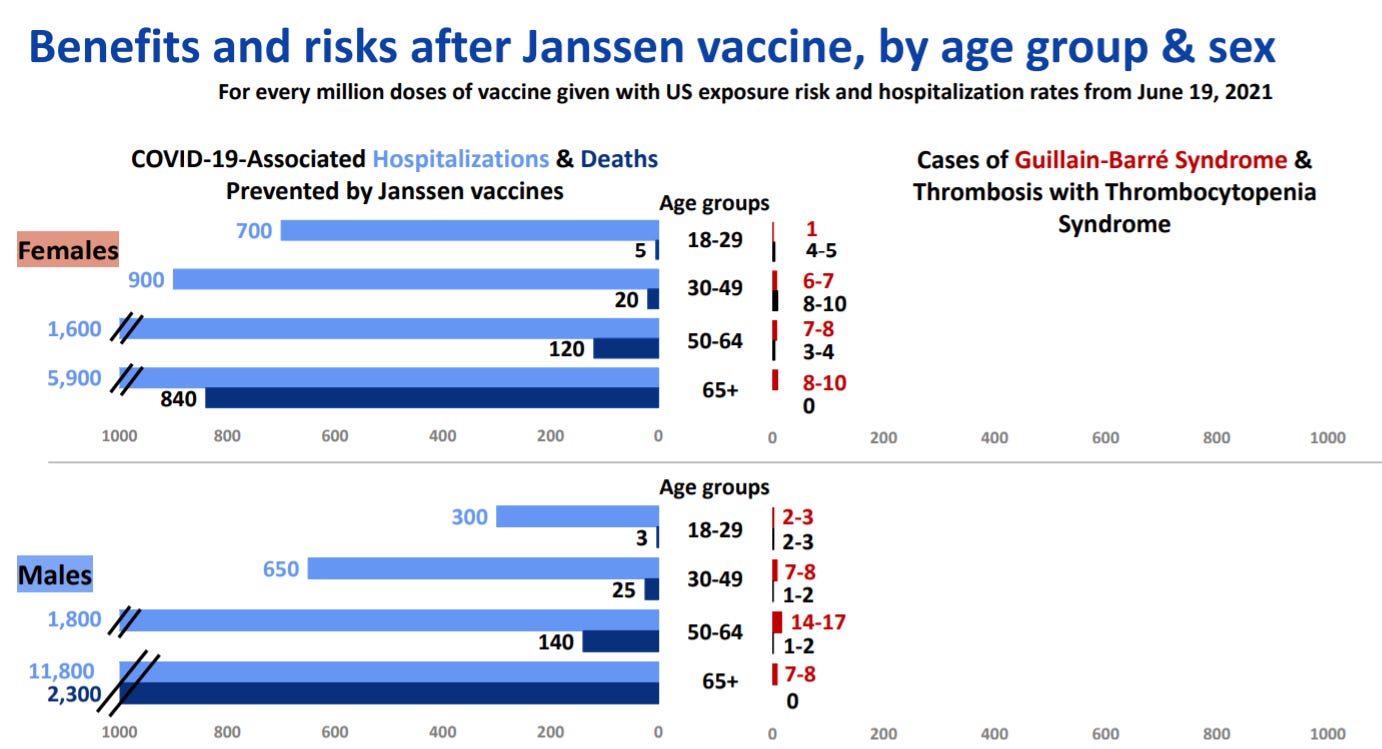This post is part 1 of a 2 part series focused on risks vs. benefits.
Part #1 (below) is not witty or clever; it is a summary of yesterday’s ACIP meeting.

Yesterday’s meeting started with a review of the epidemiological data. And just to be clear, epidemiological data aims to show patterns and trends in the occurrence of a disease in a population/our community. The current COVID situation from an epidemiological standpoint is straightforward — COVID cases are increasing, hospitalizations are increasing, and deaths are increasing. This is not good.
The current surge (which some refer to as the 4th wave) is the result of the spread of the Delta variant and the large proportion of the (local and global) population that is not vaccinated.
The pandemic is not over.
The majority of yesterday’s meeting was spent discussing —
Cases of Guillain-Barre Syndrom associated with the J&J vaccine
Vaccines and immunity among individuals who are immunocompromised.
Guillain-Barre Syndrome
Some background information to start… first, pronunciation. It is gee-ON bur-Ray syndrome (not gill-EE-on BAR). Abbreviated GBS, Guillian-Barre is a rare disorder in which the immune system attacks the peripheral nervous system. GBS causes muscle weakness and paraphysis. The exact cause of GBS is unknown, but the majority of cases report having an infection (often of the GI or respiratory system) in the six weeks before being diagnosed with GBS.1
Each year between 3000-6000 cases of GBS are diagnosed in the United States. Most people who are diagnosed with GBS are hospitalized.
As of June 30th, 100 cases of GBS have been diagnosed following vaccination with the J&J COVID-19 vaccine. On average, GBS was diagnosed 13 days after vaccination. These cases triggered a safety signal/warning - hence, the meeting of the ACIP to review and discuss the data.
The question before the ACIP yesterday was — do the benefits of the J&J vaccine outweigh the risks associated with the vaccine?
The short answer is YES — the benefits of the vaccine are far greater than the risks associated with the vaccine. On an individual level, GBS is occurring at a rate of 8.1 cases per 1 million doses of vaccine. HOWEVER, with every 1 million doses of J&J vaccine, hundreds of lives are saved and thousands of hospitalizations are prevented.

At an individual level — the likelihood of developing severe symptoms associated with COVID-19 (possibly requiring hospitalization and leading to death) is much higher than developing GBS following a vaccination. From a population/community health point of view — vaccines save lives and prevent hospitalizations.
After reviewing and discussing the data, the ACIP agreed that the benefits of the J&J COVID vaccine do outweigh the risks associated with the vaccine. HOWEVER, individuals who are seeking their vaccination should be informed about the risks associated with the vaccine. Warnings about GBS risks are also given with the annual flu shot as well as the Zoster/shingles vaccine. With all three vaccines — J&J, flu, shingles — the risk of developing GBS is rare and the benefit provided by the vaccine is HUGE.
Vaccines are safe, but they come with risks. This is true for all forms of medicines — over-the-county drugs, cancer treatments, cancer screenings, everything. To quote Dr. Camille Kotton from yesterday’s ACIP meeting —
“All of what we do in medicine is to weigh risk versus benefit.”
It is time we differentiate between these two words — safe vs. risks.
Being safe does NOT mean there are no risks. Remember my post about car crashes.
When we say a vaccine is safe we mean (at least) two things… first, that the vaccine does not amplify, or in other words, make an individual sicker after exposure to the virus. We want an individual to develop immunity following vaccination; not make it such that the vaccine leads to greater illness.2 Additionally, the vaccine should not cause severe adverse harm. We expect side effects - sore arm, bruising at the injection site, fever, fatigue. But in the majority of people receiving the vaccine, there should be no severe adverse health effects caused by the vaccine.
This is where the definition of safe meets risk.
Because every human being is unique, we cannot create any medication, including a vaccine that will 100% of the time be 100% safe for 100% of the people who need the medication or vaccination. There is some risk involved. Yes, 8 cases of GBS have occurred among 1 million individuals who have received the vaccine. There is a small risk. But 2 of every 100 COVID cases die. The vaccine is effective at preventing death.
Therefore, the risk associated with the vaccine is minimal compared to the benefits.
The COVID vaccines are safe and effective. And they are one of the most important public health tools we have available to end this pandemic. Get vaccinated!
Vaccinations in individuals who are immunocompromised
The other topic discussed at yesterday’s meeting focused on developing immunity (or lack thereof) in individuals who are immunocompromised and vaccinated. About 2.7% of all adults in the United States are immunocompromised (they have cancer or HIV or are taking immunosuppressive medications). Approximately 44% of individuals who have been hospitalized with a breakthrough case of COVID — meaning they were diagnosed with COVID and are fully vaccinated — are immunocompromised.
ACIP recommends that individuals who are immunocompromised should be vaccinated, but they observed that many immunocompromised individuals who are vaccinated have a reduced immune response. As a result, ACIP is discussing/researching the possibility of offering a third (or booster) shot to the vaccine schedule of individuals who are immunocompromised.
No decisions were made, but there is a growing body of scientific evidence that shows that with a third COVID shot, individuals who are immunocompromised have a 33-50% increase in the development of antibodies. There will definitely be more to come…
Take-aways from ACIP —
COVID cases are increasing
The Delta variant + a large proportion of individuals who are unvaccinated is driving the current surge in cases
All three COVID vaccines are safe and effect
All of medicine (including vaccines) is a matter of risk versus benefit
The benefits of the vaccines far outweigh the risks
Fun history fact about GBS… it is believed that FDR had GBS and NOT polio. Several of FDR’s symptoms were inconsistent with polio — first, FDR was 39 when he became ill. Polio is a disease of childhood. His paralysis affected both sides of his body evenly; whereas polio usually impacts one side of the body more than the other. He also experienced several well-known GBS symptoms, including facial paralysis, numbness, extreme pain, and bladder and bowel dysfunction.
Amplification of disease following vaccination has been one of the key issues plaguing the Dengue vaccine.



